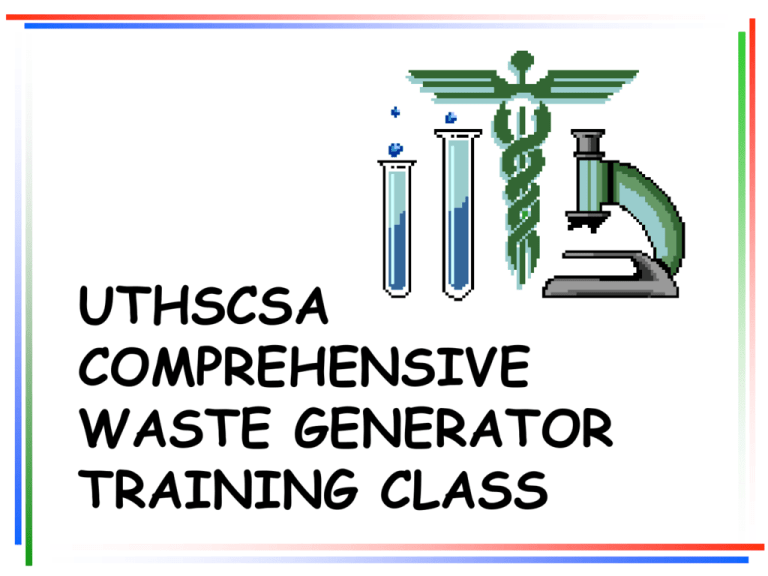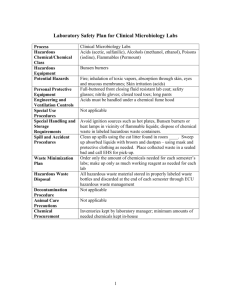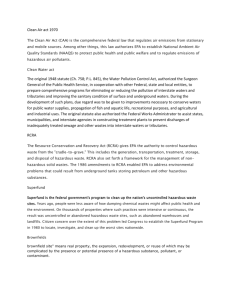HAZARDOUS WASTE GENERATOR
advertisement

UTHSCSA COMPREHENSIVE WASTE GENERATOR TRAINING CLASS SERVICES- FREE OF CHARGE! CHEMICAL PICK UP – Go to our web page and click our Chemical-pickup icon http://www.uthscsa.edu/safety/about.html – Call EH&S at 7-2955 RADIATION Waste Pickup – Go to our web page and click our Radiation- pickup icon http://www.uthscsa.edu/safety/about.html – Call EH&S at 7-2955 BIOHAZARD CONTAINERS – Go to our web page and click our Biohazard-pickup icon http://www.uthscsa.edu/safety/about.html Click on the appropriate icon to request a pick up or delivery. Then fill out the corresponding form with your information and submit your request. FACULTY AND STAFF RESPONSIBILITIES • Inform and train employees. • Retain all training records. • Implement and enforce rules and standards. • Conduct internal inspections. • Request assistance from Safety Office when needed!. EMPLOYEE AND STUDENT RESPONSIBILITIES • Follow all environmental protection and hazardous waste standards and rules. • Remain aware of the environmental releases occurring in the scope of work. • Report all hazardous conditions and environmental releases to the supervisor or advisor. EMPLOYEE AND STUDENT RESPONSIBILITIES Cont’d: • Wear or use appropriate protective equipment while handling waste materials. MORE EMPLOYEE AND STUDENT RESPONSIBILITIES! • Refrain from disposal or disposition of waste materials without proper instruction and authorization. • Ask questions to the supervisor or advisor if the safe use of equipment or operating procedures are unclear. • Request training and information when unsure how to handle hazardous wastes. HAZARDOUS WASTE GENERATOR REGULATORY AGENCIES: • EPA – Environmental Protection Agency – http://www.epa.gov • OSHA – Occupational Health and Safety Administration – http://www.osha.gov • DOT – Department of Transportation – http://www.hazmat.dot.gov • TNRCC – Texas Commission on Environmental Quality – http://www.tceq.state.tx.us • SAWS – San Antonio Water System – http://www.saws.org WHAT IS A HAZARDOUS WASTE? Hazardous by Characteristic* Toxic Poisons, mutagens, carcinogens, controlled substances, dyes, stains, mercury and other heavy metals.. Reactive Sulfides, cyanides, explosives, substances that react violently with air, water and/or produce toxic gas or vapors Corrosive Strong acids, strong bases, peroxides. Ignitable Liquids – acetone, toluene, most solvents; Gasses - hydrogen, methane, ethylene; Solids - aluminum powder, nitrocellulose. Oxidizer Diethyl ether, inorganic peroxides, nitrate compounds. Silver Containing Photo fixer, developer, x-ray film. *Including paper and rags used to clean spills. WHAT IS A HAZARDOUS WASTE?, Cont’d………. Hazardous by EPA Listing* Under the Resource Conservation and Recovery Act (RCRA), and defined in 40 CFR 261 (Code of Federal Regulations), a solid waste that, because of quantity, concentration, or physical, chemical, or infectious characteristics: (a) causes or significantly increases mortality or serious irreversible or incapacitating reversible illness, or (b) poses a substantial present or potential hazard to human health or the environment when improperly managed. About 400 wastes are listed. EPA also regulates certain materials mixed with hazardous waste regardless of the percentage, and those derived from hazardous waste. Examples of derivatives are: sludges, residues, or ashes. *State and local regulations may also apply Hazardous Waste Determination • The EPA lists some 400 hazardous wastes. The descriptions are found in 40 CFR Part 261, subpart 261, Sections 261.31-33. Such as “F” listed, “K” listed, “P” listed, also. • Wastes may be hazardous if they display an of four characteristics: ignitability, corrosiveness, reactivity, or toxicity (TCLP regulatory levels, e.g., benzene is 0.5mg/l. EPA Hazardous Wastes Listed Hazardous Wastes: • “F”- listed-nonspecific sources, spent solvents • “K”- listed-specific industries • “P”-listed-acutely hazardous, sodium azide • “U”- listed-unused off-spec. lie acrylamide (007) Characteristic Hazardous Wastes (D001D0043): • • • • Ignitability: hazardous because they may ignite, e.g., EPA Haz. No. D001 organic solvents, oxidizers Corrosivity: liquids like strong acids and bases (D002) Reactivity: solids that react violently, e.g., picric acid, peroxides, elemental sodium (D003) Toxicity: based on toxic properties, 8 metals and 32 organic compounds, like As,Hg, PB, Ba,Ag, benzene, chloroform, vinyl chloride.(D004-D0043) RECYCLABLE WSTES • • • • PCB ballasts and capacitors Batteries Oil, oil filters, and antifreeze Mercury – In thermometers (See our web page for mercury thermometer replacement program) – In switches – In amalgam fillings • Circuit boards and color monitors • Fluorescent and HID lamps Common Problems! • Improperly packaged containers. • Non-Biohazards • No “Sharps” container • No Absorbent • Too Heavy-over 30lbs. • Improperly closed • Box sides cut Common Problems! • Improperly stored chemicals. – Incompatible – Not properly labeled – No secondary containment – Expired – Deteriorated containers – No cap Incompatible Wastes • Elemental Metals/Hydrides and Acids/Alcohols • Cyanides and Acids • Sulfides and Acids • Oxidizers and Flammables • Acids and Bases • Acids and Flammables COMMON SOLUTIONS: • Proper Supervision • Daily Inspections • Continuous Training – By lab P.I. – By Safety Office • Use Reference Materials – – – – MSDS Safety Handbooks Container labels Knowledgeable Co-workers • Use Common Sense – Ask Questions – Be Aware – Safety First Think before you THROW & Ask If you don’t KNOW! UTHSCSA HAZARDOUS WASTE PROGRAM: • “CRADLE-TO-GRAVE” responsibility. – RCRA: Resource Conservation Recovery Act • Designed to comply with all Federal, State, and local hazardous waste laws and regulations. • Primary training document is the “UTHSCSA Chemical Safety Handbook” HEIERARCHY OF WASTE MANAGEMENT as Expressed by Congress in the Pollution Prevention Act of 1990 • Source reduction (most preferred) • Reuse or Recycling • Treatment to destroy or reduce hazardous characteristics • Disposal or Release (Last Resort). SOURCE REDUCTION: Reduce, Reuse, Recycle!!! – Bulking used oil. – Recycle batteries, circuit boards and color monitors. – Silver recovery. – Mercury retorting. THIRD PARTY DISPOSAL: • • • • • Lab packs Contracted Expensive Bulk drums Federal &State requirements QUARTERLY PICKUP OF CHEMICAL WASTE: New Chemical Label/Sticker! STICKERS TO MEET OSHA AND EPA REQUIREMENTS: AMALGAM RECOVERY: RADIATION WASTE MANAGEMENT: • Physical Forms: – Solid – Liquid – Tissue – Liquid Scintillation (LS) RADIATION WASTE MANAGEMENT Cont’d… • Radioisotope Separation – <300-day Half life – >300-day Half life – Exempted Isotopes • Volume Minimization – User training – Instructions • Laboratory Compliance – Weekly pickup – Returned waste – Laboratory inspections 10 RULES OF HAZARDOUS WASTE MANAGEMENT: 1. 2. 3. 4. 5. Label all chemical containers. Add words “hazardous waste”, start date, fill date, name, phone#, and dept. to container labels. Use secondary containment for all liquids. Segregate containers by hazard class. Keep containers closed at all times. 6. Fill out tags for waste collection 7. DO NOT dispose of hazardous waste in the trash, down drains, or evaporate in fume hoods. 8. Maintain emergency equipment and know what to do in the event of a spill, fire, release or explosion. 9. Use pollution prevention techniques to reduce amounts of hazardous waste. 10. Document all training.






